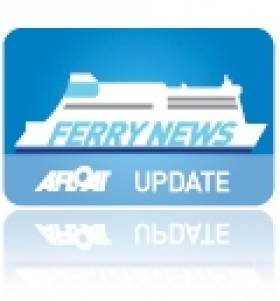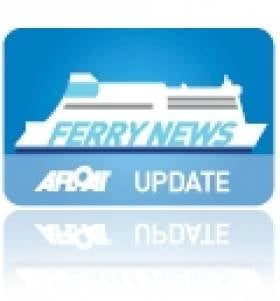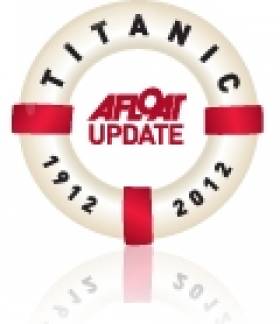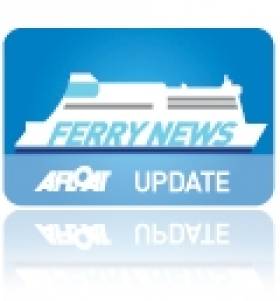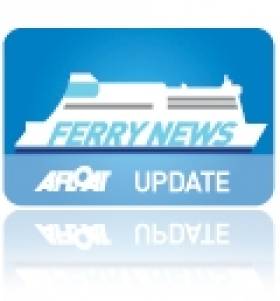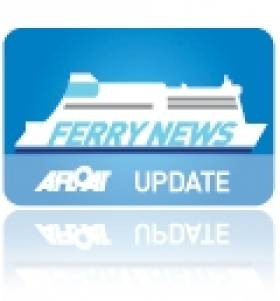Displaying items by tag: Belfast Lough
#FERRY NEWS - The veteran Stena Line ferry Stena Caledonia was spotted on sea trials in Belfast Lough last weekend pending its possible sale.
As Irish Sea Shipping reports, ASDP Ferry of Indonesia is thought to have an interest in acquiring the passenger vessel.
Stena Caledonia was withdrawn late last year to make way for Stena's second 'Superfast' ferry on the Belfast-Cairnryan route, as previously reported on Afloat.ie.
Pete Hodson captured a number of photographs as she made her way around the lough on Sunday 27 May, which can be seen HERE.
#BELFAST LOUGH - A woman has been arrested on suspicion of wasting police time after reports of a baby falling overboard from a ferry in Belfast Lough have turned out to be unfounded.
As previously reported on Afloat.ie, a large-scale coastguard search operation was mounted on Wednesday evening after two people were said to have fallen overboard from the Stena Line ferry en route to Belfast from Cairnryan in Scotland.
The woman, who is from Belfast, was recovered from the lough shortly after the alarm was raised and taken to the Royal Victoria Hospital for treatment, according to The Irish Times.
BBC News reports that the search operation was called off "after enquiries with the 37-year-old woman and her family".
A statement from the PSNI said it did "not believe there was a baby in the woman’s care on the ferry". The woman is currently being held at a police station in Belfast.
Belfast Lough Collision Captain Pleads Guilty to Crash Damage
#FERRY NEWS - The captain of a cargo ship that crashed into a passenger ferry in Belfast Lough last month has pleaded guilty to four charges related to the incident, RTÉ News reports.
More than $1 million of damage was caused when the cargo vessel Union Moon collided with the Stena Feronia on the evening of 7 March, as previously reported on Afloat.ie.
The 27,000-tonne ferry was on its way from Birkenhead in Merseyside to Belfast when it was struck by the cargo ship, captained by Miroslaw Pozniak, about a mile-and-a-half from the shore between Carrickfergus and Helen's Bay.
Fifty-five year old Pozniak, from Poland, was arrested shortly after the incident, charged with 'excess alcohol by the master of a ship'.
At a second hearing in Downpatrick Crown Court he also pleaded guilty to charges brought by the Maritime and Coastguard Agency (MCA) that include failing to keep a proper lookout, failing to safely navigate the lough, and causing serious damage to both vessels.
However, BBC News reports that he denied the charges of failing to follow safety rules and proper watch keeping arrangements, and that these will remain 'on the books' and will not be proceeded with.
Pozniak was released on continuing bail before sentencing at the end of next month. He could face up to two years in prison.
UK Laser Sailors in £50K Irish Sea Crossing Challenge
#LASER - A pair of British sailors are set to embark on an intrepid crossing of the Irish Sea using just two single-handed Laser dingies.
David Summerville and Steve Cockerill had originally planned to make the crossing in September last year, but those plans were scuppered by 50-knot gale force winds and a 12-foot tidal swell, according to Incentive Travel.
But the duo is now planning to try again, with the backing of the Ramada Plaza Southport.
“David and Steve will be covering 115 nautical miles during the challenge," said Ramada Plaza general manager Enda Rylands. "They will set off from my own home town of Dublin and finish in Southport, aiming to raise £50,000 for mental health charity Mind and the John Merricks Sailing Trust."
Summerville, a 53-year-old grandfather of two who runs a boat repair business, said the date of the challenge would again depend on weather and tidal conditions, and that the pair is ready to depart any time from mid-April to mid-September.
It's not the first time that an Irish Sea crossing has been done in a Laser as Tiffany Brien achieved the feat in 2010, sailing single-handedly the 30 miles from Portpatrick in Scotland to Belfast Lough.
But Summerville and Cockerill's ambitious undertaking, at more than three times that distance, would surely get them a place in the record books - provided the weather goes their way!
Flannigan Wins Ballyholme Ice Breaker Series
It is hard to believe that Easter is upon us and that another BYC Stena Line Icebreaker winter series is over. Once again it was a fantastic series for those competitors who took part with the full range of weather conditions and cracking racing. It would not have been possible to race without the help of all the volunteers who gave up their spare time on Sundays (and other days as well) to make this event so successful. The guys and girls who go out to provide rescue, often in freezing conditions; the Crew of the Start boat; the battery teams and race officers; the results team, and everyone else who supports..... a big thank you from everyone who took part. Results are available to download as a pdf below.
Last Sunday was a great sailing day with blue skies and moderate wind. There was a good turnout for the last race of the series with lots of different battles going on in all the fleets and of course prizes and honour at stake!!!
In the Laser Standard fleet there was, really, only going to be one winner. Gareth Flannigan had the series wrapped up well before the end but he kept focused and finished 3rd on the day which gave him the second series win. Colin Leonard made a welcome return to the racing and recorded first place last week sailing a faultless race. Chris Boyd continued his good form and was second with Gareth in 3rd. David Fletcher and Brian Spence were just behind in 4th and 5th with Trevor Patterson having his best result ever in the Icebreaker series in 6th place. (another to benefit from Bob's coaching sessions!)
That meant Gareth Flannigan was the winner of the second series with Chris Boyd in second and Hammy Baker in third.
The overall results for both Part A & B for the lasers were Gareth Flannigan in first, Chris Boyd second and David Fletcher third.
In the silver fleet Robin Moran finished 10th on Sunday which was enough to secure him first place in the Sliver Fleet. David Wilson didn't have his best afternoon and couldn't put much pressure on him so he finished 2nd overall. Paddy Brow got over excited at the start in his quest to catch Robin and was black flagged so he dropped back to 3rd overall in the silver fleet.
The Bronze fleet was won by Robert Kirk who finished 24th on Sunday but had enough of a cushion to protect his lead. Francis Kennedy was 2nd with Chris Escott in 3rd.
In the radials Suzanne Flannigan had her best race in this fleet to date and took the honours with Ryan Glynn in 2nd and Brian Bibby in 3rd. The second series was won by Ryan Glynn with Tim Brow in 2nd place and Jessica Rutherford in 3rd place.
The overall results for the Radial were 1st Ryan Glynn, 2nd Brian Bibby, 3rd Chris Eames.
The Topper fleet has a huge number of entrants although due to other commitments such as NI Squad training, many sailors couldn't attend all events. In the end, a new entrant Ben Martin managed to win Part 2 with a first in the final race - this is his first full season racing, having come from the BYC "Race Squad" last summer. Ben also managed second in the overall series with Tom Purdon winning with consistent finishes in both series, and Mark McDonough third.
The large dinghy fleet was dominated by RS400's in Part 2 filling the top 4 places with Mark McAllister from RNIYC coming first from BYC's Robin Flannigan, and Liam Donnelly. Also of note, BYC's Bob Espey (brother of Olympic hopeful Laser sailor James) who only purchased a RS400 half way through the series and has had to sail with a broken mast, finished off the last five races with two thirds and two firsts. The summer season will certainly be competitive. Wic McCready won the overall series in his K1 dinghy/keelboat.
In the multihull class, Adrian Allen showed his continued form winning Part 2 and the Overall series.
Ballyholme YC would like to thank StenaLine for their sponsorship of the event, and all the visiting competitors from clubs throughout Northern Ireland - 120 boats across 6 fleets and 22 races from the start of October until end March. The summer will seem much quieter in comparison.
As a post-script, Gareth Flannigan heads to the Laser Munsters this weekend with many other BYC members. Our next racing is the Dennis Finlay Memorial Trophy on 21st April for Lasers, and Opening Day is the following Saturday with a RUYC start line.
Garth Maxwell, Mark Mackey
#TITANIC - A Belfast man who saw the Titanic launch from the Harland and Wolff shipyards more than 100 years ago was guest of honour at the opening of Titanic Belfast at the weekend.
"It's like our Sydney Opera House," 105-year-old Cyril Quigley told BBC News of the £97 million (€116.7 million) visitor centre, opened on the 100th anniversary of the infamous ocean liner's tragic demise.
"My father and mother took me to Workman and Clark shipyard which is on the opposite side [of Belfast Lough] to watch the launch," he recalled to the Belfast Telegraph.
"I just saw a mass of metal in the gantries that they built for it and all I saw was this big thing sliding out into the water. I was only four-and-a-half."
Quigley described the new facility - designed to echo the imposing bow of the Titanic - as "wonderful", a sentiment echoed by Belfast Lord Mayor Niall O'Donnghaile who said: "The Titanic belongs to Belfast but this spectacle - Titanic Belfast - belongs to the world."
First Minister Peter Robinson was joined by Deputy First Minister Martin McGuinness at the ribbon cutting ceremony on Saturday 31 March, with the former declaring that this is "a new era in this province".
Titanic Belfast is expected to attract more than 400,000 visitors in its first year, and some 100,000 people have already purchased tickets. It will also be one of the largest employers and recruiters in Northern Ireland's tourism industry, as previously reported on Afloat.ie.
But the public's reaction so far has been mixed, according to The Irish Times, with some expressing disappointment at the lack of any large-scale model of the ship, and that the replica of the ship's famous staircase is hidden from public view in the venue's banqueting hall.
Collision Captain's Case Sent to Crown Court
#FERRY NEWS - BBC News reports that the captain of the cargo ship that collided with a passenger ferry in Belfast Lough could face up to two years in prison as his case has been sent to Crown Court.
Miroslaw Pozniak, 55, pleaded guilty on Friday to the charge of 'excess alcohol by the master of a ship' after the cargo vessel Union Moon collided with the Stena Feronia close to the Fairway buoy on Wednesday.
Both vessels were substantially damaged in the incident but there are no reports of injuries.
Newtownards Court heard yesterday that Pozniak has been fired by his employer. He will remain in custody until 20 March when the judge will again consider bail.
#FERRY NEWS - The captain of the cargo ship Union Moon, who was arrested after his vessel collided with a passenger ferry in Belfast Lough, has been charged with 'excess alcohol by the master of a ship'.
BBC News reports that the 55-year-old was set to appear in court today, following his arrest yesterday.
No one was injured in the incident on Wednesday, when the Union Moon collided with the Stena Feronia close to the Fairway buoy between Carrickfergus and Helen's Bay. Both vessels were substantially damaged.
The cargo ship, which was carrying 2,000 tonnes of aggregate, was brought back to Belfast. Philip McNamara of the Donaghdee lifeboat confirmed that a large section of her bow was missing.
Meanwhile, engineers from Stena Irish Sea are assessing the damage to their vessel to determine how long it will be out of service. The Stena Feronia sails the route from Belfast to Birkenhead in Merseyside.
The Maritime and Coastguard Agency, the Marine Accident Investigation Branch and the PSNI are all involved in the investigation.
BBC News has more on the story HERE.
- Ferry news
- collision
- Belfast Lough
- cargo ship
- Union Moon
- captain
- charged
- drink
- excess alcohol
- ferry
- Stena Feronia
- Birkenhead
- Merseyside
- court
- Fairway buoy
- Carrickfergus
- Helen's Bay
- Philip McNamara
- Donaghdee
- Lifeboat
- Stena Irish Sea
- Maritime and Coastguard Agency
- Marine Accident Investigation Branch
- psni
Captain Arrested after Belfast Lough Collision
#FERRY NEWS - The captain of the 1,500 tonnes cargo vessel Union Moon which was involved in a collision with the passenger ferry Stena Feronia in Belfast Lough last night, has been arrested by police, according to BBC News.
An investigation is under way after the accident which happened about a mile and a half from shore between Carrickfergus and Helen's Bay.
The 27,000 tonnes Stena Feronia was on its way from Birkenhead, Merseyside, to Belfast when the collision happened at about 19:45 GMT.
Coxswain of Donaghadee Lifeboat Philip McNamara said the Union Moon, was brought back to Belfast.
No one was injured, but both vessels were substantially damaged. The Maritime and Coastguard Agency (MCA) said both captains had been breathalysed, to read more about this story click HERE.
Vessels Collide in Belfast Lough
#FERRY NEWS – A passenger ferry and cargo vessel collided in Belfast Lough last night and there are no reports of any injuries. The incident happened close to the Fairway buoy about a mile and a half from shore between Carrickfergus and Helen's Bay, according to BBC News.
It is understood that the ferry Stena Feronia (1997/21,856grt) has now docked at the Stena terminal. The other vessel - a cargo ship, the Union Moon (1985/1,543grt)- was accompanied by the coastguard as it was brought back to Belfast.
The ferry was on its way from Birkenhead, Merseyside, to Belfast when the collision happened, to read more on this story click HERE.


























